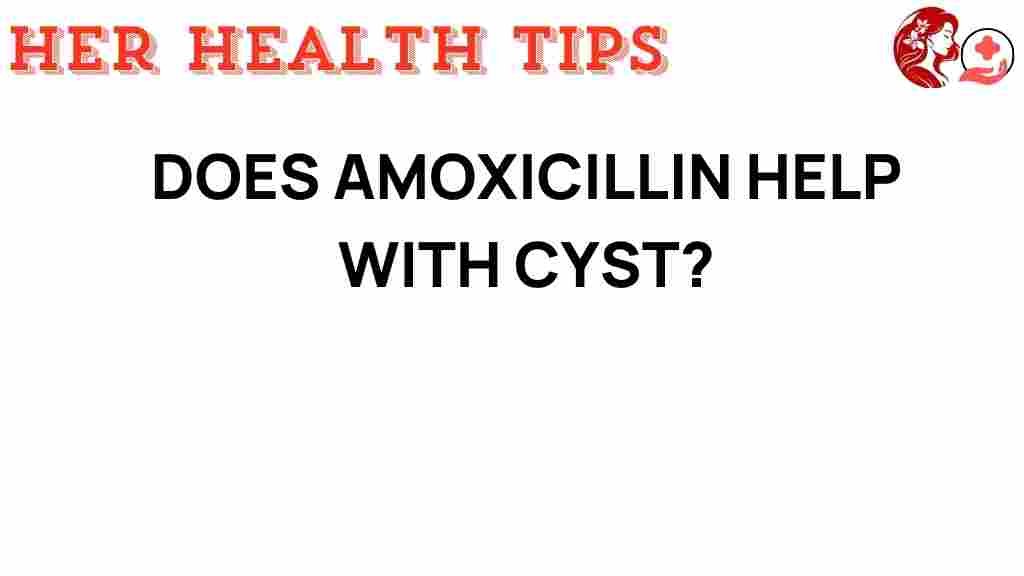Unraveling the Mystery: Does Amoxicillin Help with Cysts?
Cysts are fluid-filled sacs that can form in various parts of the body, including the skin, ovaries, and organs. They are often benign but can sometimes lead to complications or discomfort. When it comes to treating cysts, many people wonder if antibiotics like Amoxicillin can play a role in their treatment. In this article, we will explore the relationship between Amoxicillin, cyst treatment, and the broader topic of health and wellness.
Understanding Cysts
Before diving into the role of Amoxicillin in cyst treatment, it’s essential to understand what cysts are and how they develop. Cysts can arise from various causes, including:
- Infections
- Blocked ducts
- Genetic conditions
- Chronic inflammatory conditions
- Tumors
Cysts can vary significantly in size and may be asymptomatic or cause discomfort. When cysts become infected, they can lead to further complications, which is where antibiotics may come into play.
The Role of Antibiotics in Cyst Treatment
In cases where cysts become infected, antibiotics may be prescribed to help fight the infection. Amoxicillin, a broad-spectrum antibiotic, is frequently used to treat bacterial infections. However, its effectiveness in treating cysts specifically depends on the underlying cause of the cyst and whether an infection is present.
When is Amoxicillin Prescribed?
Doctors may prescribe Amoxicillin for cyst-related issues in the following scenarios:
- If the cyst is infected and there are signs of bacterial infection such as redness, swelling, and pus.
- In the case of skin cysts (like sebaceous cysts) that become inflamed or infected.
- When a cyst is associated with other infections, such as dental abscesses or respiratory infections.
It’s important to note that Amoxicillin is not a treatment for all types of cysts. For example, non-infected cysts or those caused by other issues do not require antibiotic treatment.
Consulting Medical Professionals
Before starting any medication, including Amoxicillin, it is crucial to seek medical advice. A healthcare provider will evaluate the cyst, determine its type, and decide whether antibiotics are necessary. Self-medicating can lead to complications, antibiotic resistance, and ineffective treatment.
Step-by-Step Process for Cyst Management
Here’s a step-by-step guide for managing cysts, including when to consider antibiotics like Amoxicillin:
Step 1: Identify Symptoms
Recognize the symptoms associated with cysts, which may include:
- A painful lump or swelling
- Redness or warmth in the area
- Pus or drainage from the cyst
- Fever in case of infection
Step 2: Assess the Cyst
Assess the cyst’s characteristics:
- Location and size
- Presence of infection signs
- Duration and changes in the cyst
Step 3: Seek Medical Advice
Consult a healthcare professional for a proper diagnosis and treatment plan. They may:
- Perform an examination
- Order imaging tests if necessary
- Recommend treatment options, including Amoxicillin if an infection is present
Step 4: Follow Prescribed Treatment
If Amoxicillin is prescribed, follow the dosage instructions carefully:
- Complete the full course, even if symptoms improve
- Monitor for side effects and report any adverse reactions to your doctor
Step 5: Monitor Cyst Progress
Keep track of the cyst’s condition:
- Watch for improvement or worsening of symptoms
- Return to your healthcare provider for follow-up as necessary
Step 6: Consider Additional Treatment Options
If the cyst persists or if Amoxicillin does not resolve the issue, further treatment might be needed, which could include:
- Drainage of the cyst
- Surgical removal if necessary
- Alternative medications or therapies
Troubleshooting Tips for Cyst Management
Managing cysts and their treatment can sometimes be challenging. Here are some troubleshooting tips to help you navigate potential issues:
1. Recognizing Infection
If you suspect your cyst is infected, look for symptoms such as:
- Increased pain
- Swelling or redness
- Fever or chills
Contact your healthcare provider immediately if you notice these signs.
2. Understanding Side Effects of Amoxicillin
While Amoxicillin is generally well-tolerated, some people may experience side effects such as:
- Nausea or vomiting
- Diarrhea
- Allergic reactions
If any severe side effects occur, seek medical advice right away.
3. Importance of Follow-up Appointments
Don’t skip follow-up appointments. They are crucial for:
- Monitoring the cyst’s response to treatment
- Making necessary adjustments to the treatment plan
- Evaluating the need for surgical intervention
4. Maintaining Good Skincare Practices
For skin cysts, practicing good skincare can aid in prevention and management:
- Keep the area clean and dry
- Avoid squeezing or picking at the cyst
- Use non-comedogenic skincare products
Conclusion
In conclusion, Amoxicillin can be an effective treatment for cysts when an infection is present. However, it’s essential to understand that not all cysts require antibiotic treatment. Consulting with a healthcare professional is crucial in determining the appropriate course of action. By following the steps outlined in this article, you can manage cysts effectively and promote overall wellness.
For more information on skincare and cyst management, consider checking out [this resource](Skincare and Cyst Management). If you have any specific questions about your health or treatment options, always seek medical advice from a qualified professional.
Remember, patient care is paramount, and understanding your body’s needs is the first step toward better health.
This article is in the category Conditions and created by HerHealthTips Team
